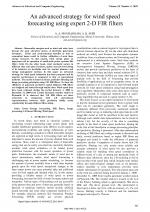| 4/2010 - 17 |
An advanced strategy for wind speed forecasting using expert 2-D FIR filtersMOGHADDAM, A. A. |
| Extra paper information in |
| Click to see author's profile in |
| Download PDF |
Author keywords
energy forecasting, FIR filters, image processing, 2-D linear filtering, wind speed
References keywords
wind(17), energy(15), power(11), speed(6), prediction(6), fuzzy(5), forecasting(5), term(4), neural(4), application(4)
Blue keywords are present in both the references section and the paper title.
About this article
Date of Publication: 2010-11-30
Volume 10, Issue 4, Year 2010, On page(s): 103 - 110
ISSN: 1582-7445, e-ISSN: 1844-7600
Digital Object Identifier: 10.4316/AECE.2010.04017
Web of Science Accession Number: 000284782700017
SCOPUS ID: 78649690688
Abstract
Renewable energies such as wind and solar have become the most attractive means of electricity generation nowadays. Social and environmental benefits as well as economical issues result in further utilization of such these energy resources. In this regard, wind energy plays an important roll in operation of small-scale power systems like Micro Grid. On the other hand, wind stochastic nature in different time and place horizons, makes accurate forecasting of its behavior an inevitable task for market planners and energy management systems. In this paper an advanced strategy for wind speed estimation has been purposed and its superior performance is compared to that of conventional methods. The model is based on linear predictive filtering and image processing principles using 2-D FIR filters. To show the efficiency of purposed predictive model different FIR filters are designed and tested through similar data. Wind speed data have been collected during the period January 1, 2009 to December 31, 2009 from Casella automatic weather station at Plymouth. It is observed that 2-D FIR filters act more accurately in comparison with 1-D conventional representations; however, their prediction ability varies considerably through different filter sizing. |
| References | | | Cited By |
Web of Science® Times Cited: 3 [View]
View record in Web of Science® [View]
View Related Records® [View]
Updated 2 weeks, 6 days ago
SCOPUS® Times Cited: 3
View record in SCOPUS® [Free preview]
View citations in SCOPUS® [Free preview]
[1] A Hybrid Model of 2d-DCT and 2d-Mycielski Algorithm for Hourly Global Solar Irradiation, FIDAN, M., SERTSOZ, M., KURBAN, M., Advances in Electrical and Computer Engineering, ISSN 1582-7445, Issue 2, Volume 20, 2020.
Digital Object Identifier: 10.4316/AECE.2020.02006 [CrossRef] [Full text]
[2] A multi-agent based energy management solution for integrated buildings and microgrid system, Anvari-Moghaddam, Amjad, Rahimi-Kian, Ashkan, Mirian, Maryam S., Guerrero, Josep M., Applied Energy, ISSN 0306-2619, Issue , 2017.
Digital Object Identifier: 10.1016/j.apenergy.2017.06.007 [CrossRef]
[3] Feasibility study of a novel methodology for solar radiation prediction on an hourly time scale: A case study in Plymouth, United Kingdom, Anvari-Moghaddam, A., Monsef, H., Rahimi-Kian, A., Nance, Helen, Journal of Renewable and Sustainable Energy, ISSN 1941-7012, Issue 3, Volume 6, 2014.
Digital Object Identifier: 10.1063/1.4878847 [CrossRef]
Disclaimer: All information displayed above was retrieved by using remote connections to respective databases. For the best user experience, we update all data by using background processes, and use caches in order to reduce the load on the servers we retrieve the information from. As we have no control on the availability of the database servers and sometimes the Internet connectivity may be affected, we do not guarantee the information is correct or complete. For the most accurate data, please always consult the database sites directly. Some external links require authentication or an institutional subscription.
Web of Science® is a registered trademark of Clarivate Analytics, Scopus® is a registered trademark of Elsevier B.V., other product names, company names, brand names, trademarks and logos are the property of their respective owners.
Faculty of Electrical Engineering and Computer Science
Stefan cel Mare University of Suceava, Romania
All rights reserved: Advances in Electrical and Computer Engineering is a registered trademark of the Stefan cel Mare University of Suceava. No part of this publication may be reproduced, stored in a retrieval system, photocopied, recorded or archived, without the written permission from the Editor. When authors submit their papers for publication, they agree that the copyright for their article be transferred to the Faculty of Electrical Engineering and Computer Science, Stefan cel Mare University of Suceava, Romania, if and only if the articles are accepted for publication. The copyright covers the exclusive rights to reproduce and distribute the article, including reprints and translations.
Permission for other use: The copyright owner's consent does not extend to copying for general distribution, for promotion, for creating new works, or for resale. Specific written permission must be obtained from the Editor for such copying. Direct linking to files hosted on this website is strictly prohibited.
Disclaimer: Whilst every effort is made by the publishers and editorial board to see that no inaccurate or misleading data, opinions or statements appear in this journal, they wish to make it clear that all information and opinions formulated in the articles, as well as linguistic accuracy, are the sole responsibility of the author.



